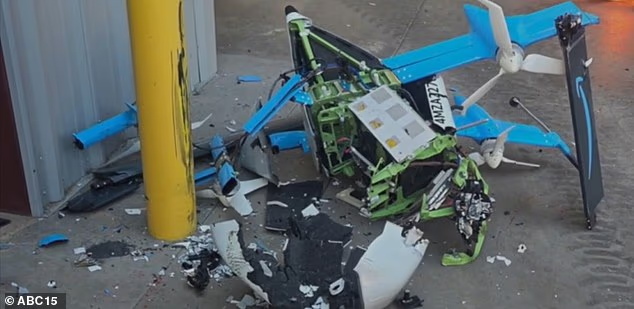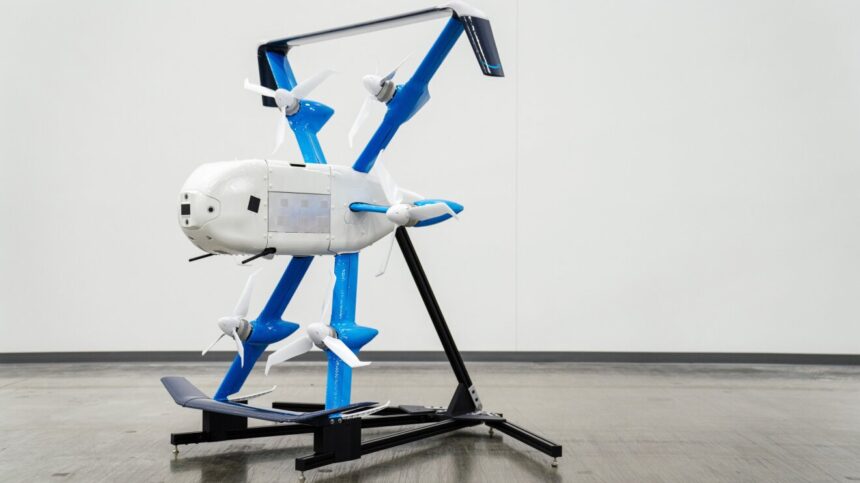Amazon’s Prime Air drone delivery program hit turbulence again — literally. Two MK30 delivery drones crashed into a construction crane in Tolleson, Arizona, on Wednesday morning. According to the Federal Aviation Administration (FAA), both drones collided with the boom of a crane around 10 a.m. local time before plummeting to the ground.
What’s Happening & Why This Matters
Eyewitnesses told local media that the drones “clipped the crane’s cable and fell within seconds.” One landed in the same parking lot as the crane, while the other dropped about 200 feet away. Both drones caught fire, prompting emergency crews to respond quickly. Fortunately, there were no serious injuries, though one person was treated for smoke inhalation.

The FAA and the National Transportation Safety Board (NTSB) are investigating the cause of the incident. In a statement, the FAA confirmed, “Two MK30 drones collided with the boom of a crane in Tolleson, Arizona… We are coordinating with Amazon and local authorities on the investigation.”
Amazon’s Response
Amazon temporarily paused drone deliveries in Tolleson following the crash but stated operations would resume within 48 hours. “We’ve completed our own internal review of this incident and are confident that there wasn’t an issue with the drones or the technology that supports them,” an Amazon spokesperson said. The company added that it’s fully cooperating with regulators while conducting additional safety checks.
The MK30 drone model — launched in Tolleson, Arizona, and College Station, Texas, last November — was touted as a safer, quieter, and more efficient successor to earlier versions. The aircraft was engineered to detect and navigate around obstacles like trampolines, clotheslines, and power lines, using advanced computer vision and AI object detection. Yet, despite these features, the crash raised concerns about how autonomous systems handle complex real-world environments.
A History of Bumpy Flights

This isn’t the first issue Amazon’s drone delivery program has encountered. Previous test crashes occurred in Texas, Oregon, and Arizona, which forced temporary pauses earlier this year. In January, the company quietly suspended deliveries after multiple flight malfunctions were reported. The MK30, designed to carry up to 5 pounds within a 10-mile radius, was expected to revolutionize local delivery logistics — but operational reliability remains under scrutiny.
Experts say incidents like this can slow Amazon’s autonomous logistics. Aviation analyst Robert Mann noted, “Each crash brings regulators closer to imposing stricter certification standards on commercial drones. Amazon will have to prove its system can operate safely near construction zones, airports, and dense areas before scaling further.”
The Air Up There
Drone delivery represents a cornerstone of Amazon’s logistics vision, combining automation, AI navigation, and environmental sustainability. Every incident, however, adds fuel to debates about airspace safety, liability, and operational readiness. As Prime Air evolves, weighing technological ambition with regulatory caution is Amazon’s highest hurdle.
TF Summary: What’s Next
Amazon will face heightened regulatory oversight and public skepticism before its drone delivery network achieves full-scale deployment. The FAA’s final report may determine whether Amazon accelerates or slows its drone expansion plans in the U.S.
MY FORECAST: Expect Prime Air to roll out additional safety protocols, software updates, and possibly human-assisted monitoring in urban testing zones.
— Text-to-Speech (TTS) provided by gspeech


